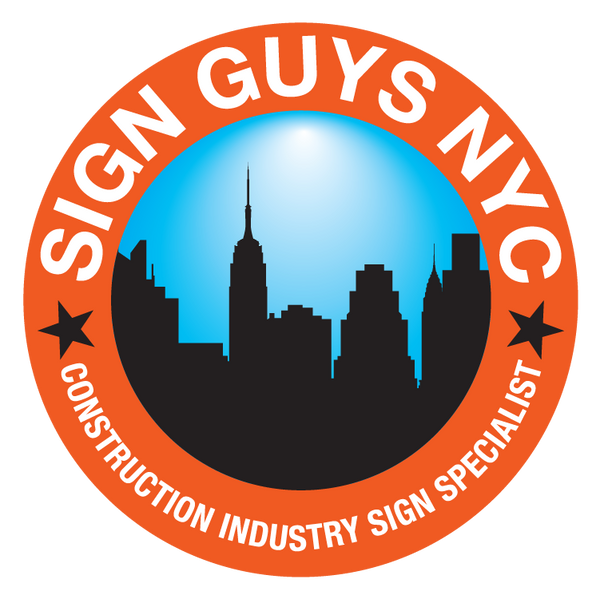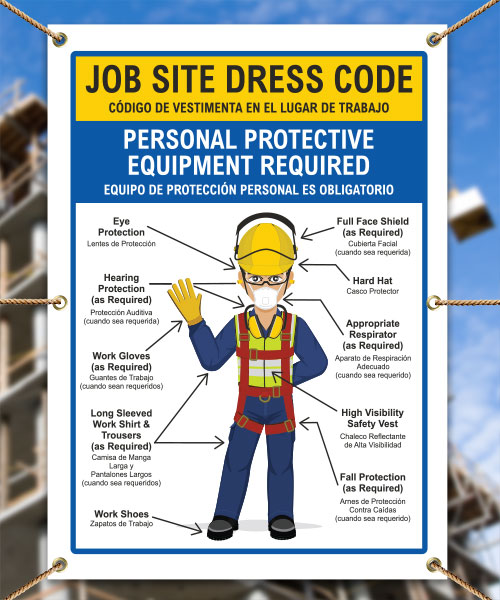
Construction sites are inherently dangerous places, and accidents can occur anytime. That's why safety is of utmost importance in the construction industry. As a result, safety signs are mandatory on construction sites to ensure the safety of workers, visitors, and the public. This article will discuss the importance of safety signage on construction sites, the different types of safety signs used, and the mandatory nature of safety signs. By the end of this article, you'll better understand why safety signs are essential in the construction industry.
Types of Safety Signs in Construction
Safety signs play an essential role in keeping workers safe on construction sites. Five safety signs are commonly used in the construction industry, each with a specific purpose and significance.

CONSTRUCTION AREA SIGNS ARE A GREAT EXAMPLE OF DANGER SIGNS
Danger Signs: indicate an immediate hazard that could cause severe injury or death. They are typically red, black, and white and have the word "DANGER" written in bold letters. Hazardous hazards warranting a danger sign include high voltage, explosives, and toxic substances.
Warning Signs: These signs alert workers to hazards that could cause injury or death. They are typically yellow and black and have "WARNING" in bold letters. Threats warranting a warning sign include slippery surfaces, heavy machinery, and hazardous materials.
Caution Signs: These signs alert workers to hazards that could cause minor to moderate injuries. They are typically yellow and have "CAUTION" written in bold letters. Threats warranting a caution sign include hot surfaces, tripping hazards, and low clearance areas.
Notice Signs: These signs provide essential information about safety procedures, equipment, or potential hazards. They are typically blue and have "NOTICE" written in bold letters. Examples of notices that warrant a notice sign include emergency exits, personal protective equipment (PPE) requirements, and safety equipment locations.
Safety Instruction Signs: These signs provide instructions on safe work practices and procedures. They are typically green and have white letters. Examples of safety instruction signs include "Wear PPE," "Keep Area Clean," and "First Aid Station."
Construction workers can quickly identify potential hazards and take appropriate safety precautions using these safety signs.
OSHA Site Safety Signs

OSHA (Occupational Safety and Health Administration) has regulations for safety signs on construction sites. These regulations ensure the safety of workers and visitors on construction sites.
OSHA requires that all safety signs on construction sites comply with the American National Standards Institute (ANSI) Z535 standard. The standard defines the colors, shapes, and symbols used on safety signs to convey specific messages.
It is essential for construction site managers to comply with OSHA regulations to avoid penalties and, more importantly, to ensure the safety of everyone on the site.

Mandatory Construction Signs
Safety signs play a crucial role in keeping construction sites safe and secure. Some signs are mandatory and must be displayed on construction sites to ensure compliance with legal requirements and keep workers safe.
Mandatory construction signs indicate actions that must be taken or prohibited to ensure safety.
Common mandatory construction signs include Hard Hat Area, No Smoking, Construction Zone Do not Enter and Authorized Personnel Only.
These signs are essential for informing workers of the potential risks and hazards on the construction site.
It is crucial to display these mandatory construction signs in the appropriate locations, such as entrances to hazardous areas or areas where PPE is required.
They should be visible, easy to read, and placed at eye level, usually around 50 to 60 inches above the floor, to ensure everyone in the area knows the dangers and safety requirements.
Failure to display these signs correctly can lead to confusion, accidents, and even legal repercussions. As a result, understanding the meaning of necessary construction signs and correctly displaying them is critical.
Personal Protective Equipment (PPE) Safety Signs
Personal protective equipment (PPE) keeps workers safe on construction sites. PPE safety signs are crucial in reminding workers to wear protective gear. These signs have a pictogram that indicates the type of PPE required for a specific hazard.
(img) the article’s sign. This sign also is great to display PPE requirements for the construction zone.
Displaying PPE safety signs in areas where PPE is required is mandatory. Employers and Site Safety Managers are responsible for guaranteeing the safety of their employees. wear appropriate PPE and follow the necessary safety procedures. Failure to do so can result in accidents, injuries, and even fatalities.
(img) PPE equipment
PPE safety signs are critical in keeping workers safe on construction sites. Employers must ensure they are correctly displayed and that workers follow the required procedures to reduce the risk of accidents and injuries.
- Displaying Safety Signs
(img) construction safety sign installed
Correctly displaying safety signs is crucial to ensure that they are noticed and understood by all workers on a construction site. Here are some best practices for showing safety signs:
Placement: Safety signs should be placed in visible locations that workers can easily notice. They should be placed at eye level and not obstructed by equipment or materials.
Lighting: Signs should be well-lit to ensure visibility at all times, especially in low-light conditions. Consider using reflective materials (link to photolumenescent)for added visibility.
Size: Signs should be large enough to be easily read from a distance. The size of the sign should be appropriate to the message it is conveying.Our Construction Site Entrance Sign is x
Large enough to be visible from distance.
Color: Color is an essential factor in sign visibility. Choose signs with bright, contrasting colors to make the sign stand out.
Cleanliness: Signs should be kept clean and free of debris or other obstructions that may obscure the message.
Some common mistakes to avoid when displaying safety signs include:
(img) improper sign placement.
Improper placement: Signs should be placed in areas that are not obstructed or readily visible to workers. Ideal areas to place your signs are at the construction site entrance and all relevant places where hazards might happen.
Poor lighting: Signs that are poorly lit or not well-illuminated can be challenging to see, especially at night or in low-light conditions.
Small size: small Signs may be challenging to read from a distance and may not effectively convey the intended message.
By following these best practices and avoiding common mistakes, construction site managers and safety professionals can help ensure that safety signs are noticed and understood by all workers on site.
In conclusion, safety signs are a crucial component of construction site safety. They convey essential information about potential hazards and required safety measures and help ensure workers know the risks involved in their work. Correctly displaying safety signs is critical to ensure their effectiveness. Sign Guys NYC offers a range of safety signs, including our Construction Site Entrance Safety Sign, to help construction site managers and safety professionals keep workers safe. Click here to learn more about our products and services.

